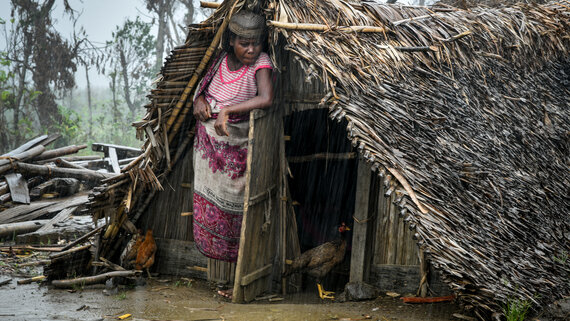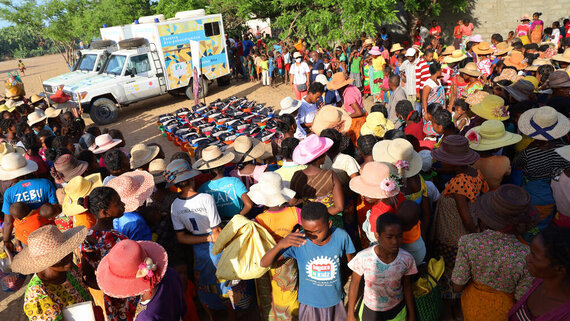Crisis overview and projections
Approximately 2.3 million people in Madagascar needed urgent humanitarian assistance in 2023, extending through the first half of 2024. The prolonged drought in the Great South and consecutive tropical cyclones in the Great Southeast of Madagascar (including Batsirai and Emnati in early 2022, followed by tropical cyclone Freddy in 2023) resulted in significant damages. The reverberations of the war in Ukraine have further exacerbated the humanitarian situation in the region. Based on the results of the July IPC Acute Food Insecurity assessment in 2023, approximately 16% of the population (over a million people) in the 22 analyzed districts are grappling with acute food insecurity. In the period from October to December 2023, it is projected that the number of people suffering from severe acute food insecurity (IPC phase 3 and above) will increase to 1.32 million, affecting 20 per cent of the population in the analyzed areas, including 79,000 people in emergency phase (IPC phase 4). It is expected that the situation will worsen during the upcoming food shortage period (January to April 2024), with more than 1.7 million people facing high levels of acute food insecurity. The main factor contributing to this deterioration is the El Nino phenomenon.
Acute malnutrition, resulting from the consequences of droughts and cyclones, continues to be critical. A SMART survey, conducted in May 2023, indicated a worsening nutritional situation, with a combined prevalence of global acute malnutrition at 10.7%, compared to 8.7% in 2022. One in every 10 children under the age of 5 is suffering from acute malnutrition. The youngest children, under 2 years old, are the most affected, with 17.2 per cent suffering from acute malnutrition. Specifically, support must increase by 60 per cent to address the 58,000 expected cases of SAM over the next 12 months according to the IPC. Additionally, coverage of prevention activities and MAM treatment remains significantly weak, and many support sites are non-functional due to an ongoing lack of inputs and supervision of community agents.

Ambalakondro, Mananjary, Madagascar
A resident of Ambalakondro village takes shelter under the roof of a house following Cyclone Freddy.
OCHA/Viviane RakotoarivonyThe WASH sector estimates that nearly 1.4 million people require WASH assistance, including over one million people in the Grand South and over 400 thousand people in the Grand South-East. Despite some improvement in the WASH sector, chronic challenges persist such as access to safe drinking water and sanitation services in the areas most affected by drought and cyclones, as well as the number of people in IPC Phase 3 or higher in the 6 districts of the Grand South and the 3 districts of the Grand South-East.
School dropout rates among children and adolescents in the Great South remain among the highest in Madagascar. This occurs in a context of persistent poverty, despite the expectations of improved food and nutritional security. The education system also faces a cumulative issue of teacher and student absenteeism. In the Great South-East, only 24.7 per cent of the schools that were damaged have been reconstructed or rehabilitated. The combined effects of cyclones and food security issues have contributed to the risk of children and adolescents dropping out of school, and this risk is expected to persist in the upcoming school year of 2023-2024.

Manampotsy, Vatovavy, Madagascar
A medical team visits a person with a leg injury.
OCHA/Viviane RakotoarivonyThe people of Madagascar have faced significant food and nutritional challenges due to drought and cyclones since 2020. These challenges have forced people to resort to negative survival practices. The persistence of taboos and practices that violate the rights of already vulnerable population has exacerbated the situation. Protection strategies are needed to address the needs of people facing risks which include chronic malnutrition, physical violence, sexual abuse, sexual exploitation and abuse, discrimination, early marriage, unwanted or early pregnancies. For people in need of protection, the scarcity of resources and continued uncertainty about their situation contributes to constant and increased levels of stress and anxiety.
In the Great South and Great South East of Madagascar, ongoing humanitarian crises continue to severely affect the lives of the population and their access to essential social services, particularly healthcare. These crises pose persistent humanitarian risks, and the most vulnerable populations are finding it increasingly difficult to access health services. The health situation is deteriorating, leading to an increase in communicable and life-threatening diseases like malaria, acute respiratory infections (ARI), diarrhea, and poliomyelitis. The use of maternal and neonatal health services has decreased, with antenatal care (4 CPN) coverage dropping from 47 per cent to 4 per cent in the Great South East and from 55 per cent to 52 per cent in the Great South.
Response priorities in 2024
In 2024, humanitarian assistance aims to reach 1.6 million people, comprising 631,000 in the Grand Sud-Est and 970,000 in the Grand Sud. The primary goal of this response is to prevent loss of life, with a particular focus on children under five years old, pregnant, and lactating women, and girls. This includes both the treatment and prevention of acute malnutrition. Furthermore, efforts are dedicated to enhancing food security and restoring the livelihoods of the most vulnerable communities. A vital aspect of this response involves providing essential healthcare services, especially in maternal health, and ensuring the continuity of basic social services, including access to water, hygiene, sanitation, prevention, and case management related to protection issues, to prevent the adoption of harmful coping mechanisms. The humanitarian response plan will also encompass anticipatory action activities designed to forestall any further worsening of the already fragile situation, considering the potential risks associated with the El Nino phenomenon. Most organizations have a presence in the targeted areas, with established offices, staff, and operational logistics resources.
Madagascar
UNFPA and WFP join forces to meet soaring reproductive health and nutrition needs in southern Madagascar

Amboasary/Grand Sud, Madagascar – Just weeks away from giving birth to her fifth child, Homoroe Haova, 33, looked down at her stomach and smiled, reassured she could give birth safely as well as feed her children in the coming weeks. Ms. Haova was among 800 women waiting in line to meet with UNFPA-supported reproductive health specialists who were visiting her village in Madagascar’s drought-stricken Grand Sud region.
Midwives on site operated from three mobile health clinics procured with generous support from the government of Japan. The clinics are among eight UNFPA-supported vehicles currently deployed in Madagascar, travelling thousands of kilometres over rough terrain to reach even the least accessible areas. In adjacent maternity tents set up beside the local health centre, UNFPA-supported medical staff issued family planning advice as social workers raised awareness on gender-based violence.
Meanwhile just a few metres away, hundreds of women, most of them heads of household, gathered to collect WFP rations of rice, vegetables and cooking oil to cover their families’ food needs for the following two weeks. The United Nations World Food Programme (WFP) reports that of nearly 3 million people living in the Grand Sud region, half need urgent food assistance.
Recurrent and relentless droughts have deprived women and girls of any means of providing for themselves or their children. Already prone to climate disasters such as cyclones, floods and drought, Madagascar experienced its worst drought in 40 years in 2021 and in the first few months of 2022 has already seen cyclones destroy thousands of homes and livelihoods.


